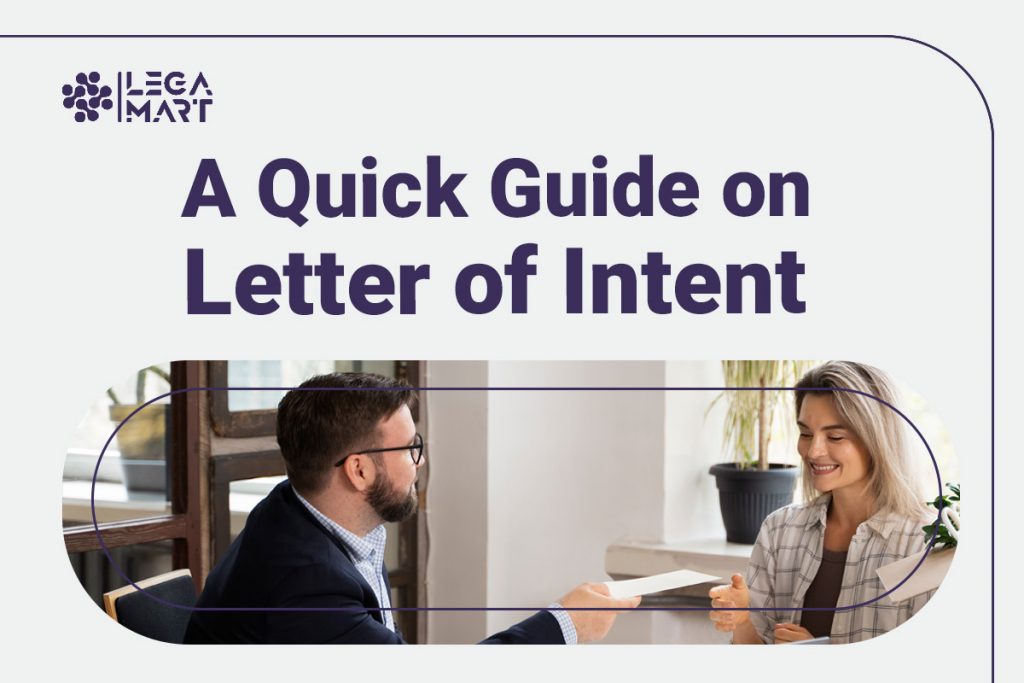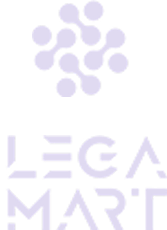Introduction
A letter of intent (LOI) is a written document that outlines the preliminary agreement between two parties before entering into a formal contract. It serves as a way for the parties involved to express their commitment to a proposed agreement and outline the key terms and conditions they have discussed. A letter of intent provides a clear understanding of the parties’ expectations and ensures that both parties are aligned before moving forward with a formal agreement.
It is important to note that a letter of intent is not legally binding but can serve as evidence of the parties’ intentions in case of any disputes. A well-drafted letter of intent can establish trust and clear communication between the parties, setting the foundation for a successful business relationship.
What are the other names for the letter of intent?
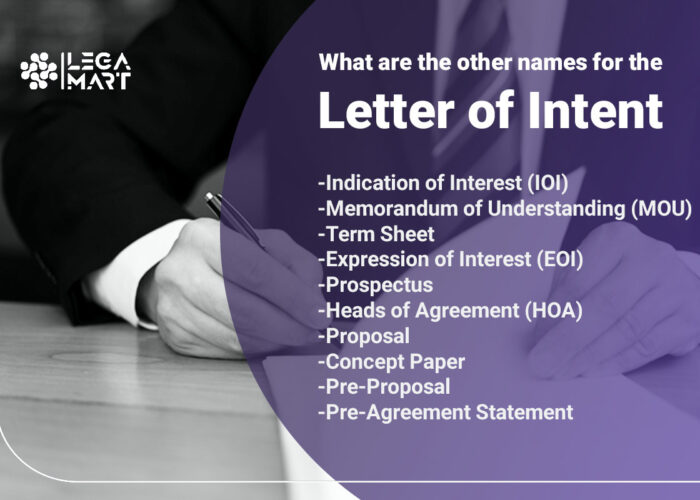
A letter of intent is also commonly referred to by the following names:
- Indication of Interest (IOI)
- Memorandum of Understanding (MOU)
- Term Sheet
- Expression of Interest (EOI)
- Prospectus
- Heads of Agreement (HOA)
- Proposal
- Concept Paper
- Pre-Proposal
- Pre-Agreement Statement
It’s worth noting that the names used for a letter of intent can vary depending on the context, industry, and geographical location. In addition, the specific name used may have legal or cultural implications, so it’s important to be aware of the terminology used in the relevant context.
What are the different types of letter of intent?
There are several types of letters of intent, including:
- Business Letter of Intent: Used in business transactions, such as mergers and acquisitions, joint ventures, or partnerships.
- Real Estate Letter of Intent: Used in real estate transactions, such as leasing or purchasing a property.
- Employment of Employment Letter of Intent: Used to confirm the status of a particular relationship, such as between a company and an employee.
- Employment Letter of Intent: Used by job applicants to express their intent to work for a company, or by employers to confirm their intent to offer a job to a candidate.
- Contract Letter of Intent: Used to indicate the intent to enter into a contract to provide goods or services.
- Academic Letter of Intent: Used by students to express their intent to attend a particular college or university.
- Grant Letter of Intent: Used by organisations to express their intent to apply for a grant.
It is important to note that the specific terms and conditions of each letter of intent may vary based on the context and industry. Therefore, the letter should always be customised to reflect the specific needs of the parties involved.
What are Advantages and Disadvantages of Letter of Intent?
LOI can serve as a useful preliminary agreement that outlines the key terms and conditions of a deal, providing clarity and serving as a foundation for further negotiations. On the other hand, it may have its drawbacks, such as potential ambiguity and the risk of the parties not reaching a formal agreement, which can lead to legal complications. Let’s delve into these aspects more deeply.
Advantages
- Demonstrates Serious Interest: The LOI signifies the buyer’s genuine interest in purchasing the business, demonstrating commitment and initiating the negotiation process in good faith.
- Access to Information: Signing an LOI provides the buyer with access to crucial information about the business, aiding in making an informed decision regarding the purchase.
- Facilitates Financing: A signed LOI can make it easier for the buyer to secure financing for the purchase, as it is a formal commitment towards the transaction.
- No Shop Clause: Including a “no shop” clause in the LOI gives the buyer a specified period to conduct due diligence without competition from other potential buyers, allowing for focused and undisturbed negotiations.
Disadvantages
- Once the LOI is signed, the seller is restricted from actively marketing the business to other potential buyers, potentially leading to missed opportunities if negotiations with the current buyer fall through.
- If negotiations fail after the LOI is signed, the seller may lose valuable time and potential opportunities with other interested buyers, leading to a setback in the selling process and potential loss of other potential deals.
What is the Purpose of LOI?
A Letter of Intent (LOI) serves various purposes, including establishing a negotiation framework and signalling serious intent in a business transaction. It outlines key terms and conditions, initiates due diligence, and often includes provisions for exclusivity and confidentiality. By committing to negotiate in good faith, it fosters a cooperative and transparent process, facilitating a positive working relationship. While typically non-binding, it can be the basis for a more comprehensive and legally binding agreement. Additionally, it sets timelines and processes for the negotiation, managing expectations and ensuring a smooth progression. Overall, the LOI’s primary function is to clarify the fundamental aspects of a deal, protect the involved parties, and announce the nature of the agreement, be it a merger or a joint venture, thereby laying the groundwork for the subsequent negotiation and finalization of the deal.
Applications of Letter of Intent
Regarding business deals, LOI is drafted by the company’s legal team, which helps provide the team with the details of their intended actions. For instance, in the case of mergers and acquisitions procedure, the use of LOI is capable of helping the firm to further plan its takeover of another company, either through cash or stock deals.
LOIs can be found beyond the business world and may be used for other tasks. For example, parents can make use of LOI to provide details about their expectations from their children in the instance that both parents die. Even though LOIs are incomparable with other legal documents, such as well, it is capable of being considered by the courts, especially while deciding on the future of the children after the death of the parents.
LOIs may also be extended to government grants or even by high-school varsity athletes, who can draft LOIs to declare their commitments, roles, and responsibilities within universities and colleges.
Is a Letter of Intent Binding?
It depends on the jurisdiction that you belong to. While most jurisdictions do not consider LOI to be a binding document, however, jurisdictions like the Dutch consider an LOI to be a legally binding document. Further, it also depends on how the LOI has been drafted by the parties. For instance, parties specifically add a provision stating that the LOI is non-binding in a business-to-business transaction. Even in the absence of an express mention of such a clause, it is possible for the courts to find an LOI binding, depending on the language being used in the document.
Here, the courts mainly rely on two factors while determining the binding value of an LOI: written expressions of intent as present in the LOI and the demonstrative actions taken by the parties after signing the LOI. Therefore, if the language of the LOI clearly expresses the intent of the parties to enter into an agreement, or the conduct of the parties after the signing of the LOI is such that it portrays their intent of entering into a binding arrangement, it is more likely for the courts to consider the LOI binding as well.
Letter of Intent vs Cover Letter
A Letter of Intent (LOI) and a Cover Letter are two distinct documents that serve different purposes in a job application process.
A Letter of Intent is a written document that outlines the preliminary agreement between two parties before entering into a formal contract. It is not legally binding but can be used as evidence of the parties’ intentions in case of any disputes.
A Cover Letter, on the other hand, is a letter that accompanies a job application or resume. It is used to introduce the candidate to the employer and provide additional information about their skills, qualifications, and experience that cannot be found in the resume. A cover letter is typically used to express interest in a specific job opportunity and to persuade the employer to consider the candidate for an interview.
In short, a Letter of Intent is used to express intent to enter into an agreement or contract, while a Cover Letter is used to express interest in a job and to provide additional information to the employer.
Letter of Intent vs Letter of Interest
The main point of difference between a letter of intent and a letter of interest is the nature of commitment involved. There exists a higher degree of commitment in a letter of intent in comparison to a letter of interest. It is preferable to write a letter of intent only when you are sure to fulfil the commitment made. While there may not be any legal consequences for not adhering to your commitment mentioned in the letter of intent, it can severely damage your reputation with the other party. On the other hand, a letter of interest doesn’t have such consequences, considering that the aim of writing a letter is to portray interest, and there is already a general consensus that letters of interest can be sent to multiple places simultaneously.
General Outline For Writing a Letter of Intent
Here is a general outline for writing a letter of intent:
- Identify the purpose of the letter: Clearly define the purpose of the letter and the type of agreement or partnership you are proposing.
- Greet the recipient: Start the letter by addressing the recipient by name, if possible. Use a formal salutation, such as “Dear [Name],”.
- State the purpose of the letter: Begin the letter by expressing your intent to enter into an agreement with the recipient. Provide a brief summary of the key terms and conditions of the proposed agreement.
- Outline key terms and conditions: Provide a clear and concise summary of the key terms and conditions of the proposed agreement. This should include the responsibilities of each party, the timeline for the agreement, and any other relevant details.
- Express commitment: Express your commitment to the proposed agreement and your intent to move forward with finalising the terms of the agreement.
- Provide contact information: Provide your contact information, such as your phone number and email address, so that the recipient can reach out to you if they have any questions or concerns.
- Close the letter: End the letter with a closing such as “Sincerely” or “Best regards”, followed by your signature and printed name.
It is important to remember that a letter of intent is not legally binding, but it can serve as evidence of the parties’ intentions in case of any disputes. Therefore, it is important to ensure that the letter is clear, concise, and accurately reflects the intentions of both parties.
Tips For Writing a Letter of Intent
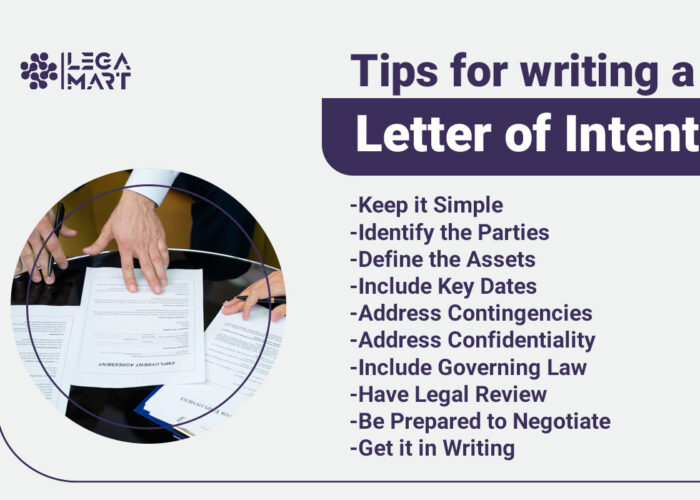
Here are some tips for writing a letter of intent:
- Keep it Simple: A letter of intent should be concise and straightforward, clearly outlining the key terms and conditions of the proposed transaction.
- Identify the Parties: The letter should clearly identify the buyer and seller and include their full names, addresses, and contact information.
- Define the Assets: Clearly describe the assets being purchased, including any inventory, equipment, intellectual property, and contracts.
- Include Key Dates: Include important dates, such as the due diligence period and the intended execution date of a formal agreement.
- Address Contingencies: Clearly outline any contingencies, such as financing or regulatory approvals, that must be met for the transaction to proceed.
- Address Confidentiality: Include a confidentiality provision to protect sensitive information from being disclosed during the negotiation process.
- Include Governing Law: Specify the governing law that will apply in any disputes or disagreements between the parties.
- Have Legal Review: Before finalising the letter of intent, it is important to have it reviewed by legal counsel to ensure that it complies with applicable laws and regulations.
- Be Prepared to Negotiate: A letter of intent is just a preliminary agreement, and it is important to be prepared to negotiate and make changes as needed.
- Get it in Writing: A written letter of intent helps ensure both parties have a clear understanding of the proposed transaction and provides a reference point for future negotiations.
What is the Purpose of LOI?
A Letter of Intent (LOI) serves various purposes, including establishing a negotiation framework and signalling serious intent in a business transaction. It outlines key terms and conditions, initiates due diligence, and often includes provisions for exclusivity and confidentiality. By committing to negotiate in good faith, it fosters a cooperative and transparent process, facilitating a positive working relationship. While typically non-binding, it can be the basis for a more comprehensive and legally binding agreement. Additionally, it sets timelines and processes for the negotiation, managing expectations and ensuring a smooth progression. Overall, the LOI’s primary function is to clarify the fundamental aspects of a deal, protect the involved parties, and announce the nature of the agreement, be it a merger or a joint venture, thereby laying the groundwork for the subsequent negotiation and finalization of the deal.
Managing Your Letter of Intent
Considering that companies need to handle multiple legal documents simultaneously, it can be challenging to keep them updated. Further, manual documenting and updations require extra costs and time. In the case of LOI, if the document has been written incorrectly or is misplaced, it can delay the execution of other legal agreements in the future.
These problems can be solved through digital contracting tools and strategies, such as automated workflows. This is an approach often used by businesses to make their flow of tasks and documents perform in accordance with the business rules in an automated and independent fashion.
Through automated workflows, the parties can enter into better collaborations and clearer negotiations while helping them stay updated with the additions and subtractions made to the document.
Samples of Various Types of Letter of Intent
General Letter of Intent
Dear [Recipient’s Name],
I am writing this letter to express my strong interest in the [Position Name] role within your organisation. After researching your company and its mission, I am confident that my skills, experience, and passion align with your goals and objectives.
I have [number of years] years of experience in [relevant field or industry]. During this time, I have honed my [skill or experience], and I am eager to bring my expertise to your team. I am particularly drawn to your organisation’s commitment to [key aspect of the company’s mission or values].
I have a proven track record of [achievement or recognition]. I am confident that I have the necessary qualifications and expertise to positively impact your organisation, and I am eager to contribute to your success.
I would appreciate the opportunity to discuss further my qualifications and how I can contribute to your organisation. I am available for an interview at your convenience and would be honored to provide additional information or references upon request.
Thank you for considering my letter of intent. I look forward to the opportunity to discuss this opportunity further and to take the next steps towards joining your team.
Sincerely,
[Your Name]
Letter of Intent For Asset Purchase(non-binding)
Here is a sample non-binding letter of intent for an asset purchase:
[Date]
[Seller’s Name and Address]
[Buyer’s Name and Address]
Dear [Seller’s Name],
I, [Buyer’s Name], am writing this letter to express my intent to purchase the assets of [Company Name], including but not limited to all of its physical assets, intellectual property, and any other associated assets, subject to the terms and conditions set forth below.
This letter of intent is intended to serve as a preliminary expression of my interest in purchasing the assets of [Company Name] and is not binding upon either party. Our goal is to reach a mutually acceptable agreement on the terms and conditions of the asset purchase as soon as possible.
It is my understanding that [Company Name] is currently in [describe current situation of company]. I believe that the assets of [Company Name] would be a valuable addition to [Buyer’s Company Name], and I am confident that I have the resources and experience necessary to successfully operate and grow the business.
Please confirm in writing your acceptance of this letter of intent and that you are willing to enter into negotiations for the asset purchase. I would like to move forward with due diligence as soon as possible, with the goal of reaching a mutually acceptable agreement within [number of days or weeks].
Thank you for your time and consideration.
Sincerely,
[Your Name]
Essential Clauses That are Often Included in a Letter of Intent For an Asset Purchase
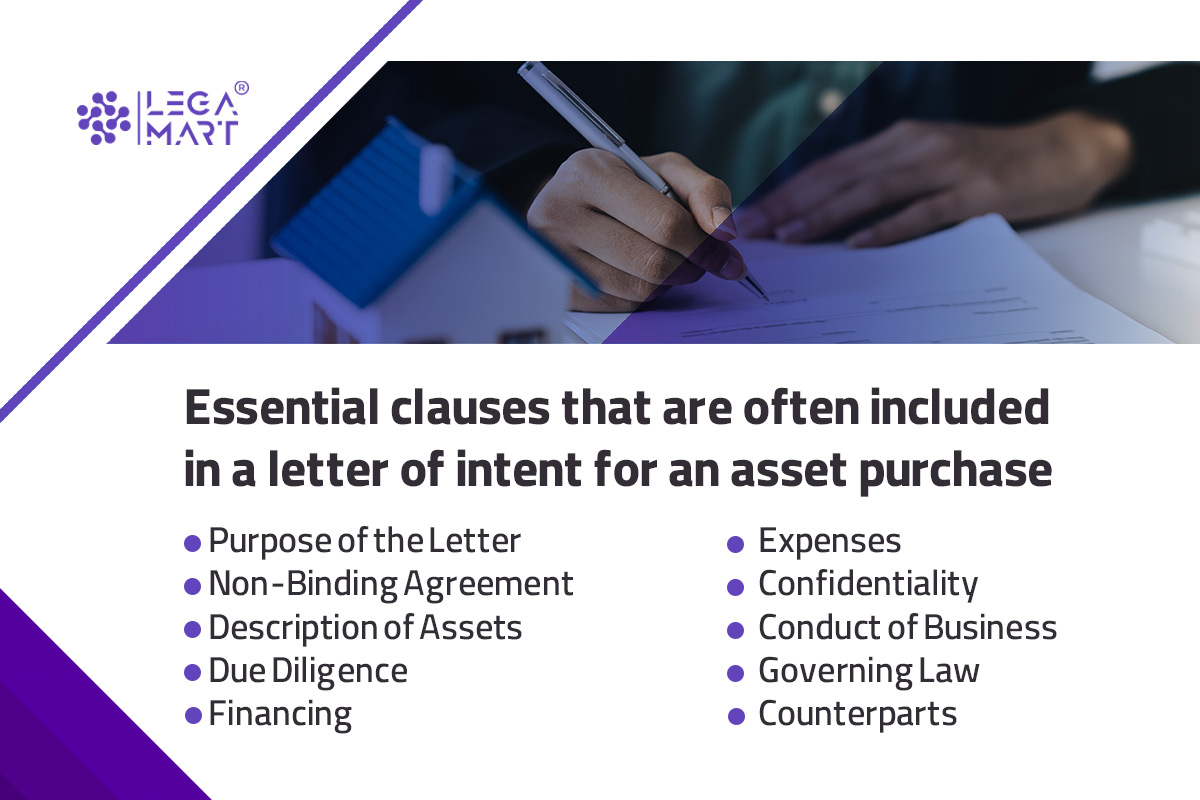
- Purpose of the Letter: The purpose of the letter should be clearly stated, including the assets being purchased and any conditions that must be met for the purchase to proceed.
- Non-Binding Agreement: It is important to specify that the letter of intent is not a binding agreement and that a formal agreement will be negotiated and executed at a later date.
- Description of Assets: A clear description of the assets being purchased should be provided, including any inventory, equipment, intellectual property, and contracts.
- Due Diligence: The letter should include a provision allowing the buyer to conduct due diligence on the assets and business being purchased, including access to financial records, contracts, and other information.
- Financing: The letter should specify any contingencies related to financing, including the buyer’s obligation to obtain suitable financing and the right to make a final determination as to the suitability of financing.
- Expenses: The letter should specify which party will be responsible for transaction-related expenses, such as legal, accounting, and due diligence fees.
- Confidentiality: The letter should include a provision requiring both parties to maintain confidentiality about the proposed transaction until a formal agreement is executed or until otherwise agreed upon by both parties.
- Conduct of Business: The letter should specify how the seller should conduct its business during the negotiation period and any restrictions on the sale of assets or the entering into new contracts.
- Governing Law: The letter should specify the governing law that will apply in any disputes or disagreements between the parties.
- Counterparts: The letter should include a provision allowing for the execution of the letter in counterparts, which allows each party to sign a separate copy of the letter and for all signed copies to be considered as one original.
Letter of Intent for a Job
A letter of intent for a job is a written expression of interest in a job opening, typically submitted along with a resume. The letter of intent highlights your qualifications and skills and why you are a good fit for the position. Here are some tips for writing a letter of intent for a job:
- Tailor the letter to the job: Customise the letter to the specific job you are applying for, mentioning the job title, company, and how you learned about the opening.
- Show enthusiasm: Express your interest in the position and enthusiasm for the company and the role.
- Highlight relevant skills and experiences: Briefly summarise your relevant skills and experiences, focusing on how they make you a good fit for the job.
- Mention specific achievements: Provide specific examples that demonstrate your qualifications for the job.
- Ask for an interview: End the letter by asking for an interview and including your contact information.
- Keep it professional: Ensure that the letter is well-written, professional, and free of errors.
- Follow up: After submitting your letter of intent and resume, it is a good idea to follow up with a phone call or email to confirm that your application has been received and to express your continued interest in the position.
Example:
Dear [Hiring Manager’s Name],
I am writing to express my interest in the [Job Title] role at [Company Name]. I learned about this opportunity through [Source of Job Posting] and was immediately drawn to the company’s [Company’s Unique Trait].
As a highly motivated and results-driven professional with [Number of Years] years of experience in [Relevant industry], I believe I have the skills and qualifications that would make me a great fit for this role. In my current position at [Current Company], I have developed expertise in [Key Skills/Responsibilities] and have consistently delivered [Key Achievements].
I am confident that my skills and experience, combined with my passion for [Company’s Industry], would enable me to make a significant contribution to [Company Name]. I would welcome the opportunity to discuss this position further and to learn more about how I can contribute to your team.
Thank you for considering my application. I look forward to the opportunity to further discuss my qualifications with you in an interview.
Sincerely, [Your Name]
Letter of Intent for Job Opening
A letter of intent to an employer after seeing a job opening is a written expression of interest in the job and a request for consideration. The letter should highlight your skills and experiences and explain why you would be a good fit for the job. Here are some tips for writing a letter of intent to an employer after seeing a job opening:
- Address the letter to a specific person: Research the company and address the letter to a specific person, such as the hiring manager or human resources representative.
- Show enthusiasm: Express your excitement about the job opening and your interest in the company.
- Highlight relevant skills and experiences: Briefly summarise your relevant skills and experiences, focusing on how they make you a good fit for the job.
- Mention specific achievements: Provide specific examples of your achievements that demonstrate your qualifications for the job.
- Ask for an opportunity to discuss the job further: End the letter by asking for an opportunity to discuss the job further and to provide more information about your qualifications.
- Keep it professional: Ensure that the letter is well-written, professional, and free of errors.
- Follow up: After submitting your letter of intent, it is a good idea to follow up with a phone call or email to confirm that your application has been received and to express your continued interest in the job.
Example
Dear [Hiring Manager’s Name],
I am writing to express my interest in the [Job Title] role at [Company Name]. I was very excited to see this job opening and believe that my skills and experience make me a strong candidate for the position.
With [Number of Years] years of experience in [Relevant industry], I have developed a deep understanding of [Key Skills/Responsibilities] and have consistently delivered [Key Achievements]. In my current role at [Current Company], I have demonstrated my ability to [Key Achievements/Skills].
I am particularly impressed by [Company’s Unique Trait] and am excited about the opportunity to join a team that is dedicated to [Company’s Mission]. I would welcome the opportunity to discuss this position further and to provide more information about my qualifications.
Thank you for considering my application. I look forward to the opportunity to discuss my qualifications with you in more detail.
Sincerely, [Your Name]
Letter of Intent For a Job in the Same Company
Dear [Hiring Manager’s Name],
I hope this letter finds you in good spirits. I am writing to express my strong interest in the [Job Position] recently posted on the [Company] career website. I am confident that my skills and experience make me a strong fit for this role, and I am eager to bring my passion for [relevant skills or experiences] to the team.
As a current employee of [Company], I have had the privilege of witnessing the company’s growth and success first-hand. I am proud to be a part of such a dynamic and innovative organisation, and I am excited about the opportunity to contribute even further to the company’s mission and goals.
In my current role as [Current Position], I have honed my skills in [relevant skills or experiences]. I have a proven track record of [achievements or successes], and I am confident that these experiences have prepared me well for the challenges of the [Job Position]. I am particularly drawn to this role because of the opportunity to [reason for interest in the role].
I believe that my experience and skills make me a strong candidate for the [Job Position]. I am committed to taking on new challenges and to continuously developing my skills and abilities, and I am confident that this role will provide me with the opportunities to do so.
Thank you for considering my application. I look forward to discussing my qualifications further and learning more about the role and how I can contribute to the team.
Sincerely,
[Your Name]
Letter of Intent For a Job Application
Dear [Hiring Manager’s Name],
I am writing to express my strong interest in the [Job Position] recently posted on [Job Board or Company Website]. I am excited about the opportunity to bring my skills, experiences, and passion for [relevant skills or experiences] to your team at [Company Name].
I am a highly motivated and dedicated professional with [number of years] years of experience in [relevant field or industry]. My experience has equipped me with a solid foundation in [skill or experience], and I am confident that I have the knowledge and abilities to make a meaningful contribution to your team.
I am particularly drawn to this role because of the opportunity to work with a dynamic and innovative company like [Company Name], and to be a part of a team that is dedicated to [relevant mission or values]. I am eager to bring my enthusiasm and drive to this role and to play a key role in helping the company achieve its goals.
I have attached my resume for your review and would be happy to provide additional information or references if needed. I am available for an interview at your convenience, and I look forward to the opportunity to discuss my qualifications further.
Thank you for considering my application. I am confident that I have the skills and experience to make a positive impact on your team, and I am eager to take on this exciting new challenge.
Sincerely,
[Your Name]
Conclusion
Writing a letter of intent can be critical in achieving your goals, whether securing a job, a position in a program or establishing a business partnership. By following the tips and guidelines outlined in this guide, you can create a compelling letter that captures the attention of your reader and effectively conveys your purpose. Most often, the conditions mentioned in the LOI are taken into account when drafting business contracts, employment contracts, etc. Hence, you should consult a legal expert to understand what should and shouldn’t be mentioned in the letter.
It’s essential to begin with a clear understanding of your objectives and a well-defined target audience. This will help you structure your letter and craft a message that resonates with your reader. It’s also important to use a professional tone and to be concise and straightforward in your communication.
When writing a letter of intent, remember to emphasise your strengths, experience, and achievements that make you a suitable candidate or partner. Don’t forget to include any relevant background information, and be specific in your approach. Additionally, provide a clear call to action and express your enthusiasm for the opportunity.
Frequently Asked Questions (FAQs)
What are the general rules for writing a letter of intent?
Prepare your LOI to be concise and engaging. Be sure to use your words smartly while avoiding any jargon or adjectives not supported by relevant facts. I prefer including persuasive and logical arguments, which emphasize the nature of the agreement and the engagement between the parties.
What are the steps following the signing of a letter of intent?
Once the parties have signed the LOI, they can either negotiate and sign the final agreement or perform the required due diligence. Additionally, it is possible to conduct both these procedures in parallel, depending on the party preferences.
Is there an LOI for business transactions?
A letter of intent for a business Transaction is a document used to implicate the intention of two parties for further business. It is not legally binding, but it serves as a formal declaration of the parties’ commitment to move forward with a more comprehensive and binding agreement, such as joint ventures, mergers and acquisitions, and real estate lease agreements, the letter outlines the essential terms and conditions of the proposed transaction, including responsibilities and expectations of each party.
Can a company reject you after giving you a letter of intent?
Employers may issue an LOI as a way to express their interest in hiring a candidate and to begin the process of finalising the employment arrangement. However, various factors, such as a change in business circumstances, the results of background checks or reference checks, or other considerations, may lead the employer to retract the offer or decide not to hire the candidate. It’s crucial for both parties to understand that the LOI is not a guarantee of employment.

